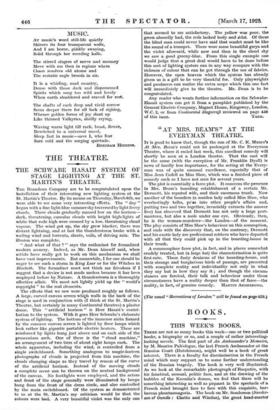THE THEATRE.
THE SCHWABE HASAIT SYSTEM OF STAGE LIGHTING AT THE ST. MARTIN'S THEATRE.
THE Reandean Company are to be congratulated upon the installation of their interesting new lighting system at the St. Martin's Theatre. By its means on Thursday,March8th, we were able to see some very interesting effects. The " day " began with a fine light-blue summer sky traversed by light fleecy clouds. These clouds gradually massed low on the horizon— dark, threatening, cumulus clouds with bright high-lights of white that rode high were crossed by a low, threatening cloud vapour. The wind got up, the sky grew blacker, there was distant lightning, and at last the thunderstorm broke with a wailing wind and torrents, sheets, veils, of driving rain. The illusion was complete.
" And what of that ? " says the enthusiast for formalized modern scenery. Indeed, as Mr. Dean himself said, when artists have really got to work on this mechanism we shall have vast improvements. But meanwhile, I for one should be eager to see such a storm in King Lear or for the Witches in Macbeth. The formalizer must not think me frivolous if I suggest that a device is not made useless because it has been employed before by Nature. A thunderstorm is a thoroughly effective affair. We must not lightly yield up the " world's copyright " to the real elements.
The effects that we saw were produced roughly as follows. A large, curved canvas screen which walls in the back of the stage is used in conjunction with (I think at the St. Martin's Theatre, but certainly in many Continental theatres) a plaster dome. This " artificial horizon " is Herr Hasait's contri- bution to the system. With it goes Herr Schwabe's elaborate system of lighting. The bottom of the immense niche formed by the concave canvas screen is lighted by floor lamps which look rather like gigantic portable electric heaters. These are reinforced by lights hung just above and on each side of the proscenium arch. One of these is the " cloud machine," an arrangement of two tiers of about eight lamps each. The whole apparatus, including the wind, is controlled from a single switchboard. Something analogous to magic-lantern photographs of clouds is projected from this machine, the clouds changing shape as they travel by reason of the curve of the artificial horizon. Instead of the moving clouds a complete scene can be thrown on the neutral background of the canvas. No footlights were employed, and the actors and front of the stage generally were illuminated by lamps hung from the front of the dress circle, and also controlled by the main switchboard. Of the system as demonstrated to us at the St. Martin's my criticism would be that the colours were bad. A very beautiful violet was the only one that seemed to me satisfactory. The yellow was poor, the green absurdly bad, the reds lacked body and éclat. Of these the blind man could never have said that scarlet must he like the sound of a trumpet. There were some beautiful greys and the violet aforesaid, while now and then in the cloud sky we saw a good greeny-blue. From this single example one would judge that a great deal would have to be done before this sort of lighting system can in any way compare with the richness of colour that can be got through the use of fabrics. However, the open heaven which the system has already given us is a gift to be very thankful for. Only playwrights and producers can realize the extra scope which this one fact will immediately give to the theatre. Mr. Dean is to be congratulated.
Any reader who wants further information on the Schwabe- Hasait system can get it from a pamphlet published by the General Electric Company, Magnet House, Kingsway, London, W.C. 2, or from Continental Stagecraft reviewed on page 448










































 Previous page
Previous page